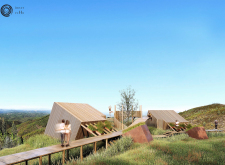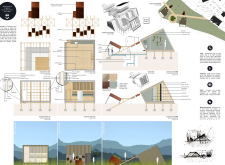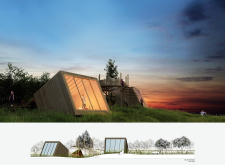5 key facts about this project
One of the major functions of this project is to provide a retreat that facilitates mindfulness and meditation practices. By carefully considering the layout and orientation of the structures, the architecture encourages the occupants to engage with the tranquil setting. The spaces are designed to be versatile, accommodating a variety of activities, from yoga sessions to workshops and community gatherings. Each cabin is distinct yet integrated into the overall composition, fostering a sense of community while allowing for personal space.
A key element of the architectural design is the modular approach taken for the structures. Their geometric forms—characterized by angular rooftops and varied elevations—create visual dynamism and enhance the users' experiences with differing perspectives of the landscape. The utilization of raised wooden walkways to connect these cabins exemplifies thoughtful consideration for both user mobility and ecological preservation, reducing the environmental footprint of the development.
In terms of materiality, the project prioritizes sustainable options that resonate with the surrounding environment. Timber is used prominently throughout the design, chosen for its warmth and natural aesthetic. This choice not only provides structural support but also aligns with the overall ethos of sustainability. The extensive use of glass invites ample natural light into the interiors, offering unobstructed views of the landscape, which encourages occupants to appreciate their surroundings. The incorporation of corten steel adds a contemporary finish to the project, serving as an example of modern materiality that develops a natural patina over time, blending seamlessly with the natural backdrop.
The project presents unique designing approaches that demonstrate a deep understanding of environmental engagement. Green roofs and planters are integrated into the design, contributing to local biodiversity and further enhancing the connection with nature while improving energy efficiency. Passive and active sustainable systems, such as rainwater collection and efficient ventilation, are discreetly embedded in the architectural layout, underscoring a commitment to ecological sustainability.
Insights into the user experience are central to the architectural approach taken. The design encourages occupants to explore the site, promoting mindfulness not just through individual reflection but also through interaction with communal areas. The dialogue between structures and the site amplifies the architectural narrative of tranquility, emphasizing the importance of carefully crafting spaces that resonate with the natural rhythms of life.
For those interested in delving deeper into the project, exploring the architectural plans, sections, and overall designs will offer further clarity on how these elements coalesce to create a distinct environment that is both functional and enriching. Engaging with the architectural ideas behind this project can provide valuable insights into contemporary approaches to architecture that prioritize sustainability and user engagement, reinforcing the relevance of well-considered design in enhancing our daily experiences.


























